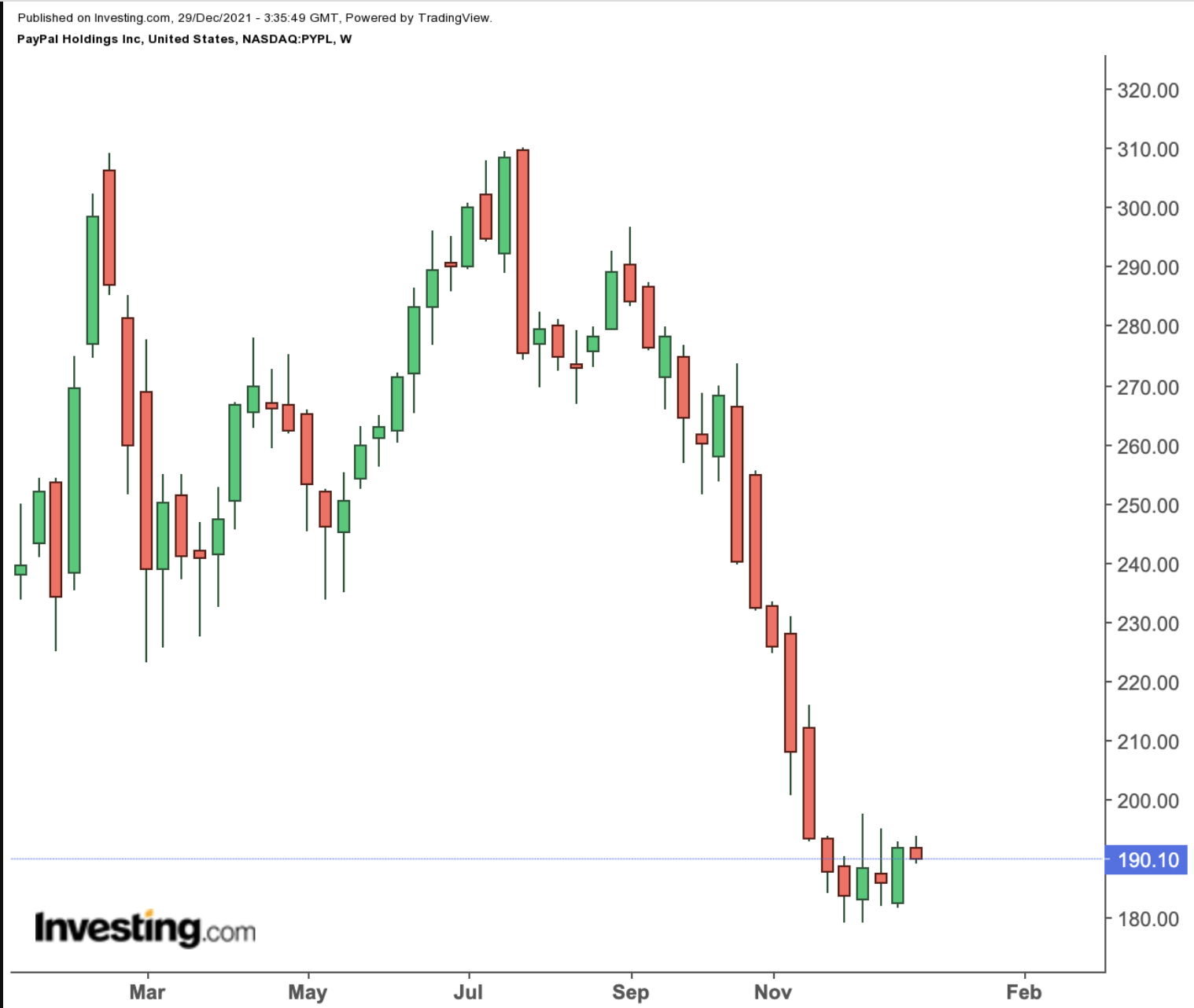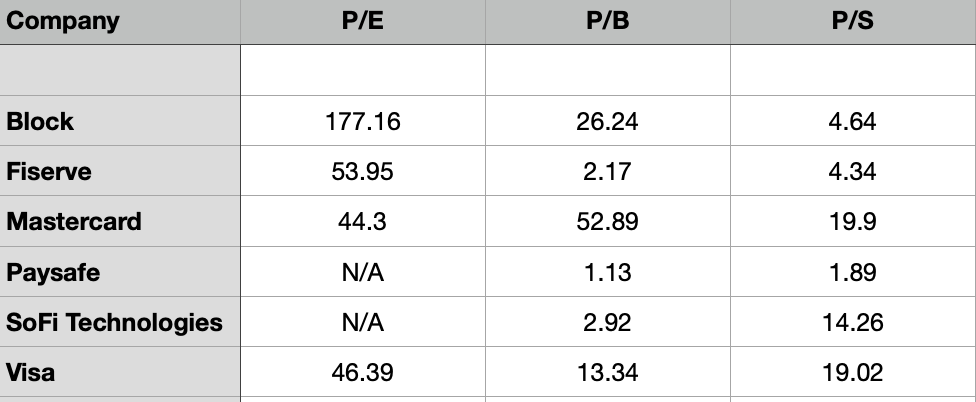U.S. consumer inflation rose by less than expected in November; CPI gained 2.7%
Investors in fintech giant PayPal (NASDAQ:PYPL) have seen the value of the stock decline 18% since the beginning of the year. In comparison, the NASDAQ 100 index, which PYPL stock is a member of, has returned about 29% year-to-date.

On July 26, PYPL shares went over $310 to hit a record high. However, the stock is currently hovering around the $192.20 level, a decline of 38% from its peak. The stock’s 52-week range has been $179.15 - $310.16 and the market capitalization stands at $225.6 billion.
Recent metrics highlight:
“The transaction value of the digital payments market was US$5.44 trillion in 2020, and it is projected to be worth US$11.29 trillion by 2026.”
And PayPal is one of the most important names in digital payment services. For instance, more than 70% of U.S. e-commerce sites have the PayPal button as a payment option.
The platform released Q3 financials Nov. 8. During the quarter, it had 416 million active accounts with $310 billion in total payment volume (TPV). There were 4.9 billion payment transactions, or an average of 44 payment transactions per active account.
Net revenue was $6.18 billion, an increase of 13% year-over-year. Non-GAAP EPS came in at $1.11, up 4%.
The growth of 20% in free cash flow of $1.29 billion was impressive. But, for Q4, the outlook was weaker than analysts’ estimates. Management expects to generate between $6.85 billion and $6.95 billion in net revenue in the fourth quarter.
Prior to the release of the quarterly results, PYPL stock was around $230. On Dec. 1, it went below $180. Since then buyers have come in and pushed it to $192.20.
What To Expect From PYPL Stock
Among 48 analysts polled via Investing.com, PayPal stock has an “outperform" rating.

Chart: Investing.com
Analysts have a 12-month median price target of $271.58 on the stock, implying an increase of more than 41% from current levels. The 12-month price range currently stands between $39 and $366.
On the other hand, according to a number of valuation models, such as those that might consider P/E, P/B or P/S multiples or DuPont analysis, the average fair value for PYPL stock, via InvestingPro stands at $214.38, implying an upside potential of 11%.

Chart: InvestingPro
Meanwhile, if we look at the company’s financial health determined by ranking more than 100 factors against peers in the information technology sector, we find that in terms of growth and profit health, PayPal scores 4 out of 5 (top score). Its overall performance is rated “good.”
Trailing P/E, P/B and P/S ratios for PYPL stock are 45.7x, 10.2x, and 9.2x. By comparison, those metrics for peers stand at 45.7x, 10.2x, and 9.2x. Put another way, despite the recent decline in price PYPL stock still looks frothy.
We can also take a closer look at comparable metrics for several other fintech names, including Block (NYSE:SQ), Fiserv (NASDAQ:FISV), Mastercard (NYSE:MA), Paysafe (NYSE:PSFE), SoFi Technologies. (NASDAQ:SOFI) and Visa (NYSE:V). They are:

These metrics show that valuations in the high-growth fintech segment vary. Therefore, potential investors would need to do further due diligence to find the best stock appropriate for their goals.
Finally, those who also pay attention to technical charts might be interested to know that despite the recent decline in price, several of PYPL's intermediate-term indicators are still cautioning investors.
In the coming weeks, we expect PayPal stock to potentially trade in a range between $180 and $200, and form a base from which a new leg can start.
Therefore, investors who are not concerned with short-term choppiness in PYPL stock could consider buying it around these levels.
Those who are long-term bullish on PayPal shares but believe that the short-term choppiness might continue could use options. For instance, they could put together a diagonal debit spread on PYPL stock using "Long-Term Equity Anticipation Securities” (LEAPS) options. We have covered numerous examples before (here and here).
The strategy, which is also referred to as “Poor Man's Covered Call” or “Poor Person's Covered Call,” involves options. This strategy is not appropriate for most retail investors, therefore, they should regard the following discussion for information purposes rather than a trading recommendation.
A Diagonal Debit Spread On PYPL Stock
Buying 100 shares of PayPal would currently cost around $19,200 based on the stock's intraday price on Tuesday, a considerable investment for many people.
But in this strategy, a trader would first buy a “longer-term” call with a lower strike price. At the same time, the trader would sell a “shorter-term” call with a higher strike price, creating a long diagonal spread.
In other words, the two call options for the underlying stock (i.e., PYPL in this case) have different strikes and different expiration dates. The trader goes long one option and shorts the other to make a diagonal spread.
In this LEAPS covered call strategy, both the profit potential and risk are limited. The trader establishes the position for a net debit (or cost). The net debit represents the maximum loss.
Most traders entering such a strategy would be mildly bullish on the underlying security—here, PayPal.
Instead of buying 100 shares of PayPal, the trader would buy a deep-in-the-money LEAPS call option where that LEAPS call acts as a surrogate for owning the PayPal stock.
At time of writing, PYPL was $192.20 (Editor's note: It finished the day at $190.10, but we'll stick with the author's midday calculations throughout this post).
For the first leg of this strategy, the trader might buy a deep in-the-money (ITM) LEAPS call, such as the PYPL Jan. 19, 2024, 150-strike call option. This option is currently offered at $65.75 (mid-point of the current bid and ask spread). In other words, it would cost the trader $6,575 instead of $19,198 to own this call option that expires in over two years.
The delta of this option is about 0.80. Delta shows the amount an option’s price is expected to move based on a $1 change in the underlying security.
In this example, if PayPal stock goes up to $193.20, the current option price of $65.75 would be expected to increase by approximately 80 cents, based on a delta of 0.80. However, the actual change might be slightly more or less depending on several other factors that are beyond the scope of this article.
So an option’s delta increases as one goes deeper into the money. Traders would use deep ITM LEAPS strikes because as delta approaches 1, a LEAPS option's price moves begin to mirror that of the underlying stock. In simple terms, a delta of 0.80 would be like owning 80 shares of PYPL in this example (as opposed to 100 in a regular covered call).
For the second leg of this strategy, the trader sells an out-of-the-money (OTM) short-term call, such as the PYPL Feb. 18, 2022, 195-strike call option. This option’s current premium is $11.75. In other words, the option seller would receive $1,175, excluding trading commissions.
There are two expiration dates in the strategy, making it quite difficult to give an exact formula for a break-even point for the trade.
Maximum Profit Potential
The maximum potential is realized if the stock price is equal to the strike price of the short call on the expiration date of the short call.
In other words, the trader wants the PYPL stock price to remain as close to the strike price of the short option (i.e., $195 here) as possible at expiration (on Feb. 18, 2022), without going above it.
In our example, the maximum return, in theory, would be about $1,267 at a price of $195.00 at expiry, excluding trading commissions and costs. We arrived at this value using a profit and loss calculator.
Without the use of such a calculator, we could also arrive at an approximate dollar value. Let’s take a look:
The option seller (i.e., the trader) received $1,175 for the sold option.
Meanwhile, the underlying PYPL stock increased from $192.20 to $195. This is a difference of $2.80 for 1 share of PYPL or $280 for 100 shares.
Because the delta of the long LEAPS option is taken as 0.8, the value of the long option will in theory increase by $280 X 0.8 = $224.0 (However, in practice, it might be more or less).
The total of $1,175 and $224 comes to $1,399. Although it is not the same as $1,267, we can regard it as a good approximate value.
Understandably, if the strike price of our long option had been different (i.e., not $150.00), its delta would have been different, too. Then we need to use that delta value to arrive at the approximate final profit or loss value.
Therefore, by not investing $19,200 initially in 100 shares of PYPL, the trader’s potential return is leveraged.
Ideally, the trader hopes the short call will expire out-of-the money (worthless). Then, the trader can sell one call after the other, until the long LEAPS call expires in about two years.
Finally, we should note that a diagonal debit spread requires regular position management.
